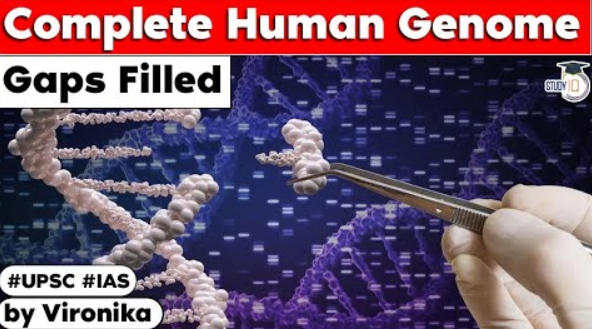Table of Contents
- Nearly two decades ago, when scientists published the map of the human genome for the first time, it was hailed as a breakthrough.
- That was incomplete, however: about 8% of the human DNA was left unsequenced.
- Now, in a series of papers published in Science, a large team has accounted for that 8%, completing the picture of the human genome for the first time.

- The work was done by the Telomere to Telomere (T2T) consortium, which included leadership from researchers at the National Human Genome Research Institute (NHGRI), part of the National Institutes of Health; University of California, Santa Cruz; and University of Washington, Seattle.
- NHGRI was the primary funder of the study.
What is the human genome?
- A genome is a chemical compound. It represents an organism’s complete set of DNA.
- It contains all the information of the past evolution and codes for instructions needed to develop and direct activities to run the life of the organism.
- A set of DNA is made of two twisting paired strands, often referred to as a double helix.
- A unit of DNA containing particular set of attributes and information is called gene the word more commonly used by people to refer to hereditary matters.
- According to the National Human Genome Research Institute, each DNA strand is made of four chemical substances, called nucleotide bases. These bases carry what we call the genetic information.
- Each base is represented by one of the four letters A, T, C and G. They are arranged in pairs.
- Virtually every single cell in the body contains a complete copy of the approximately 3 billion DNA base pairs, or letters, that make up the human genome.
- With its four-letter language, DNA contains the information needed to build the entire human body.
Why it matters
- A complete human genome makes it easier to study genetic variation between individuals or between populations.
- A genome refers to all of the genetic material in an organism, and the human genome is mostly the same in all people, but a very small part of the DNA does vary between one individual and another.
- By constructing a complete human genome, scientists can use it for reference while studying the genome of various individuals, which would help them understand which variations, if any, might be responsible for disease.
What was missing
- The genetic sequence made available in 2003 from the Human Genome Project, an international collaboration between 1990 and 2003, contained information from a region of the human genome known as the euchromatin. Here, the chromosome is rich in genes, and the DNA encodes for protein.
- The 8% that was left out was in the area called heterochromatin. This is a smaller portion of the genome, and does not produce protein.
- There were at least two key reasons why heterochromatin was given lower priority. This part of the genome was thought to be “junk DNA”, because it had no clear function. Besides, the euchromatin contained more genes that were simpler to sequence with the tools available at the time.
What’s in the 8%
- The new reference genome, called T2T-CHM13, includes highly repetitive DNA sequences found in and around the telomeres (structures at the ends of chromosomes) and the centromeres (at the middle section of each chromosome).
- The new sequence also reveals long stretches of DNA that are duplicated in the genome and are known to play important roles in evolution and disease.
- The fact that the sequences are repetitive is enlightening, scientists said. The findings have revealed a large number of genetic variations, and these variations appear in large part within these repeated sequences.
- A significant amount of human genetic material turns out to be long, repetitive sections that occur over and over.
- Although every human has some repeats, not everyone has the same number of them. And the difference in the number of repeats is where most of human genetic variation is found.
What Next
- The T2T consortium used the now-complete genome sequence as a reference to discover more than 2 million additional variants in the human genome.
- These studies provide more accurate information about the genomic variants within 622 medically relevant genes.
- The complete sequence will be valuable for studies that aim to establish comprehensive views of human genomic variation.
- Many research groups have already started using a pre-release version of the complete human genome sequence for their research.
- The new T2T reference genome will complement the standard human reference genome, known as Genome Reference Consortium build 38 (GRCh38), which originated from the Human Genome Project and has been updated since.
Question:
The process of transfer of hereditary character from one generation to another is known as………..?
- Genes
- Mutation
- Variation
- Genetics
Latest Burning Issues | Free PDF


























 WhatsApp
WhatsApp